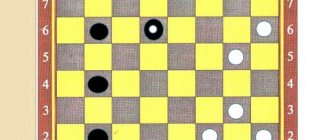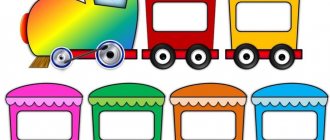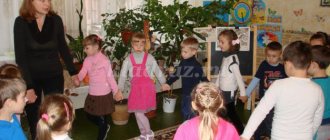Intellectual game - a lesson in the preparatory group “What? Where? When?"
Purpose: To give children an idea of the game “What? Where? When?”, introduce the rules of the game.
Tasks: - continue to develop the ability to listen to other people’s opinions, defend your answer, justifying it; — expand and deepen children’s ideas about the state; — consolidate knowledge about state symbols; - develop logical thinking, intelligence, the ability to solve simple mathematical problems, the ability to navigate on a piece of paper, the ability to construct a sentence correctly, - develop cognitive interest in children; - cultivate feelings of mutual assistance and perseverance; - evoke joyful emotions in children, bring celebration into everyday life; - cultivate goodwill and contact in relationships with peers. Vocabulary work: experts, symbol, hero,
Preliminary work: - examination of illustrations for the game.
Methodical techniques:
1. Conversation. 2. Creating a situation of success. 3. Search questions. 4. “Name the extra,” “Opposite words,” “Correct the mistake.” 5. Physical education session - musical break “If you have fun, do this.” 6. Mathematical problems. 7. Graphic exercise. 8. Speech dialogue. Black box. 9. Summing up the game.
Progress of the lesson
Educator: Guys, today I invite you to play a game with me: “What? Where? When?". Maybe some of you saw it on TV? (Slide) - children's answers. Do you know which bird is the symbol of the game What? Where? When? (owl symbol). Why do you think this particular bird? (Slide.)
The owl is considered a symbol of wisdom and knowledge. Then I will tell you about the rules of the game: pay attention, there are envelopes on the table with questions that you will need to answer. For each correct answer a point is counted. I wish you success and hope that you will cope with all the tasks. So let's begin.
(Music begins.) - Good afternoon, dear guests! We are in the intellectual club “What? Where? When?" Today a team of television viewers plays against a team of experts from the preparatory group.
1. First round. (Music, spinning top. An adult spins the drum.)
Presenter : Sector No. 1 fell out. This blitz was sent by the teacher of the senior group, Valentina Nikolaevna.
What are the colors of the national flag (what do they mean?)
What is the name of the President of Russia?
How many days are there in a week?
What did they call a “warrior” in Rus' before?
What flower blooms first in a forest clearing in spring?
The team of experts earns a point. (put a card with the number 1 on the board)
2. Presenter. Round 2. (Spin the drum. Music.)
Presenter : Sector No. 2 fell out. This blitz was sent to us by senior teacher Elena Nikolaevna.
“ Name the odd one out ” 1. Winter, book, spring, summer. (Explain.) 2. One, two, circle, four. 3. Plus, minus, winter, equal. 4. Circle, square, march, triangle.
“Name the opposite words ” 2. High - (low).
3. Long - (short).
5. Heavy - (light).
6. Cheerful - (sad).
7. Thick - liquid.
Let's continue the game. Round 3. (Spin the drum. Music.)
3. Presenter: Sector No. fell out. 3. This question was sent to us by the teacher of the middle group, Ekaterina Sergeevna Ruban.
"Correct the mistake"
1. The worm pecked the starling.
2. The song was sung by the nightingale.
3. The furry caterpillar ate the tit. 4. There was a vase in the flower.
5. The children collected the children in a basket.
The team of experts earns a point. (For a correctly completed task, get a point.) the treble clef , we’ve got a musical break, friends.
Musical break (physical education minute).
4. Presenter : We continue the game. Round 4. (Spin the drum. Music.)
This question will be asked to us by the teacher of the second junior group, Irina Aleksandrovna.
Attention! 1. The apples in the garden were ripe, we had time to taste them. Five are rosy, liquid, three are sour. How many are there? (8.)
2. The hedgehog gave the hedgehogs eight leather boots. Which of the guys will answer - how many of them were hedged? (2.)
3. There are tubs against the wall, each tub contains one frog. If there were five tubs, how many frogs would there be? (5.)
4. Name the previous and subsequent numbers (5,8,11).
Presenter : The experts answered correctly. The expert team earns a point.
5. Presenter: Round 5. Music. The sector fell out. Attention experts! This question will require increased attention and accuracy from you. It is necessary to perform a graphic dictation; to do this, go to the easels. But before you start the task. Let's stretch our hands. Now take your markers and start the task.
1. graphic dictation. 1 cell to the right, 1 to the top. 2 right, 1 down, 1 right, 4 up, 1 left, 1 down, 2 left, 2 up, 1 left, 1 down, 1 left. 1 down. 1 right and 3 down.
So let's see how you did. Attention to the screen. Swap places and check with each other; if there are mistakes, correct them. The team of experts earns a point.
Musical break (physical education minute).
2. Presenter : The game continues. Round 6 Music. The sector has fallen out; this question is asked to you by music director Liya Anatolyevna.
Dear experts! What time of year is this poem talking about?
The snow is already melting, the streams are flowing...
The nightingales will soon whistle, and the forest will be covered with leaves... (“Spring” by A. Pleshcheev.) Do you know a poem about spring?
Host : Correct answer. The team of experts gets a point. Round 8 . We begin to spin the drum. Music.
Presenter : Attention experts! We have a black box sector. You must find out what kind of item is in the black box.
Black box (reading). “They entered the hall and immediately saw this object. The princess looked at him and said “What a beauty I am!”, Baba Yaga looked at him and said: “What a monster!”, Kolobok looked at him and said: “I want the same for myself, only round!” This item is in a black box, what is it? (mirror).
Presenter: Attention, the correct answer. The team of experts gets a point.
Educator: So we finished our game. Guys, what question did you like best? Guys, I congratulate you on your brilliant victory.
Self-analysis of the open lesson “What? Where? When?"
Purpose of the lesson: To give children an idea of the game “What? Where? When?”, introduce the rules of the game.
Give children joy and pleasure from gaming activities.
The tasks and types of children's activities are set taking into account the integration of educational areas:
Area "Cognition"
Promote the development of cognitive activity, cognitive processes, logical thinking.
— expand and deepen children’s ideas about the state; — consolidate knowledge about state symbols; - develop logical thinking, intelligence, the ability to solve simple mathematical problems, the ability to navigate on a sheet of paper, the ability to construct a sentence correctly,
Communication area
Develop coherent speech
Area "Socialization"
Encourage children to engage in play situations together with adults. To foster independence, activity, a sense of camaraderie, the desire and ability to work in a team.
Music area
Enrich children's musical experiences, promote the creation of positive emotions and psychological comfort.
Health area.
Develop auditory attention and perception, hand-eye coordination.
I believe that the more interesting the lesson is, the more children are involved in the game, the more knowledge and skills they acquire. Therefore, I showed a non-traditional form of activity with children in the form of a quiz game. This is a kind of consolidation of the knowledge and skills that the child already possesses.
The topic and objectives of the lesson correspond to the level of mental development of children. During the lesson, the unity of educational, developmental and educational tasks was observed. All parts of the lesson are logical and consistent, connected to each other by a single game plot.
The techniques in the lesson were of a playful nature, based on playful learning situations that encouraged children to engage in independent activities and apply their accumulated experience.
At each moment, questions of a search nature, questions of quick wits and logical thinking were used - contributed to the effectiveness of the lesson, increasing cognitive and mental activity.
The water part of the lesson involved organizing the children, switching attention to the upcoming activity, stimulating interest in it, and creating an emotional mood for the upcoming activity.
The main part was built mainly on the use of all groups of methods: gaming, visual, verbal, practical, which reflected the same topic and were closely interrelated.
Changing types of activities helped maintain children's attention and performance throughout the game.
In order to relieve tension, increase efficiency, and also activate children, a physical education session was organized.
In the final part, I summarized the activities using the method of analyzing the success of completing tasks.
For each moment of the lesson, visual aids were selected that stimulated and activated children’s mental activity. Their placement and use were rational and thoughtful.
Based on the results of the educational activities carried out directly, the following conclusions can be drawn:
Children love these games. This arouses in them the excitement of competition and, of course, interest in activities.
I think that the game motivation aroused the children’s interest and the activity was good.
The children worked actively and enthusiastically at all stages of the lesson, were attentive, interested in the lesson, and showed activity and independence in various types of activities. They received maximum positive emotions.
I believe that the lesson was held at an optimal pace, in a friendly psychological atmosphere,
I summed up the results and assessed the children’s participation in the lesson.
I believe that I managed to achieve the goal of the lesson through the implementation of all the assigned tasks.
The final game-activity “What? Where? When?" preparatory group
Goal: Consolidation of knowledge in the sections “Sound pronunciation”, “Teaching elements of literacy”, “Lexico-grammatical categories”.
Tasks:
Correctional educational tasks.
- Strengthen the ability to identify “vowel sound”, “hard consonant sound”, “soft consonant sound”; Strengthen the ability to correlate the sound pattern of a word with a word;
- To consolidate knowledge about the difference between vowels and consonants;
- Exercise the ability to conduct sound analysis and synthesis of words;
- Exercise the ability to analyze and synthesize a proposal.
Corrective and developmental tasks.
- Develop phonemic processes, speech hearing, auditory attention, expressiveness of speech;
- Develop thinking, visual memory, sustained attention;
- Develop general motor skills and continue to teach children to navigate in space;
- Develop coordination of speech with movement, rhythm and smoothness of movements;
- Continue automation of correct pronunciation and differentiation of all previously delivered sounds in free activity.
Correctional and educational tasks:
- Develop the ability to listen to the answers of comrades;
- Develop the skills of self-control and self-esteem;
- Cultivate cognitive interest in the sound side of speech;
- Fostering activity, independence, and initiative in educational activities.
Methods and techniques:
Visual (manuals, pictures);
Verbal (joint speech activity);
Gaming (surprise moment, dynamic pauses);
Practical (modeling, completing tasks, exercises).
Preliminary work : familiarization with vowel and consonant sounds, finding and inventing words with a given sound, sound analysis of words, dividing words into syllables, working with sentences.
Duration: 35 minutes
Number of children: 3 people
Materials: sound castles and human sounds, sound diagrams of words, sound chips, object pictures, wood, colored pencils, Whatman paper, glue stick.
Venue: speech therapist's office
Progress of the lesson
1. Organizational moment.
There are envelopes on the playing field. In the middle of the field there is a top with an arrow. Music is playing. Children take their places at the table (each child has a picture, he must determine the last sound in the name of his picture and find a picture on the table whose name will begin with this sound).
2. Reporting the topic of the lesson, updating existing knowledge.
Speech therapist. Good afternoon, dear experts. Good afternoon, dear viewers. Attention! We are starting the final series of games “What? Where? When?". A team of experts and a team of spectators - kindergarten teachers - take part in the game. There are experts at the gaming table. (The speech therapist names the children). For each correct answer there is a prize (! If the audience believes that the children did not cope with any task, then the audience takes the prize). Score 0:0
First round. The first child spins the top. The arrow points to the envelope with the photo.
Speech therapist: Plays against experts...
The viewer reads the task: Dear experts! Listen carefully to a number of words, determine what sound is heard in all the words? What do you know about this sound?
Speech therapist: You successfully completed the task.... The score becomes 1:0 in favor of the experts. Along with the point you earn, you receive a prize picture.
Second round. The second child spins the top. The arrow points to the envelope with the photo.
Speech therapist: Plays against experts...
The viewer reads the task : Dear experts! Place items in three baskets. In the first basket are items with one syllable in the name, in the second - items with two syllables in the name, in the third - items with three syllables in the name.
Speech therapist: You successfully completed the task.... The score becomes 2:0 in favor of the experts. Along with the point you earn, you receive a prize picture.
Speech therapist: And now I invite everyone to a tea break (breathing exercises: short, quick inhalation through the nose, slow, long exhalation through the mouth. We use cups of water and straws)
Third round. The third child spins the top. The arrow points to the envelope with the photo.
Speech therapist : Plays against experts...
The viewer reads the task : Dear experts! I really love inventing and playing different games. And I suggest you play tic-tac-toe. If a word begins with a consonant, put an X, if it starts with a vowel, put an O.
Speech therapist: You successfully completed the task.... The score becomes 3:0 in favor of the experts. Along with the point you earn, you receive a prize picture.
Fourth round. The fourth child spins the top. The arrow points to the envelope with the photo.
Speech therapist: Plays against experts...
The viewer reads the task: Dear experts! There are pictures in front of each of you. Make a sound diagram of the word - the name of the picture.
Speech therapist: You successfully completed the task.... The score becomes 4:0 in favor of the experts. Along with the point you earn, you receive a prize picture.
Speech therapist: Musical break. I suggest everyone get up and rest a little.
Fifth round . The fifth child spins the top. The arrow points to the envelope with the photo.
Speech therapist: Plays against experts...
The viewer reads the task: Dear experts! Check whether the sentences are written correctly. If not, fix it.
— The apple is round, and the lemon is sour;
— The vase is crystal, and the glass is light;
— The butterfly has large wings, and the dragonfly has transparent wings;
- Salt is salty, and sugar is white;
— A white mushroom with a brown cap, and the fly agaric is inedible.
Speech therapist: You successfully completed the task.... The score becomes 5:0 in favor of the experts. Along with the point you earn, you receive a prize picture.
Sixth round. The top is spinning.
The viewer reads the task: Dear experts! Attention, Black Box! Guess the riddle and find out what item is in the Black Box.
I often look at it. I'm spinning and spinning in the front. I braid my hair and straighten my suit. (Mirror).
Children open the box and find a mirror. Show the mirror.
Speech therapist: When do we use a mirror in class?
Children: When we do articulation gymnastics.
Speech therapist: What exercises did you and I perform in front of the mirror?
Children show exercises.
3. Summary of the lesson.
Speech therapist : By completing tasks from the audience, you received prize pictures. Place the pictures in order and use the first sounds in the pictures to form a word.
Children complete the task and give the answer: SCHOOL. If during the game the children did not cope with any task, then they must guess what sound they are missing.
Speech therapist: Dear experts! You have completed all the tasks of the game. Let's thank your rival spectators, share with them your impressions of the last game and tell them what SCHOOL is.






